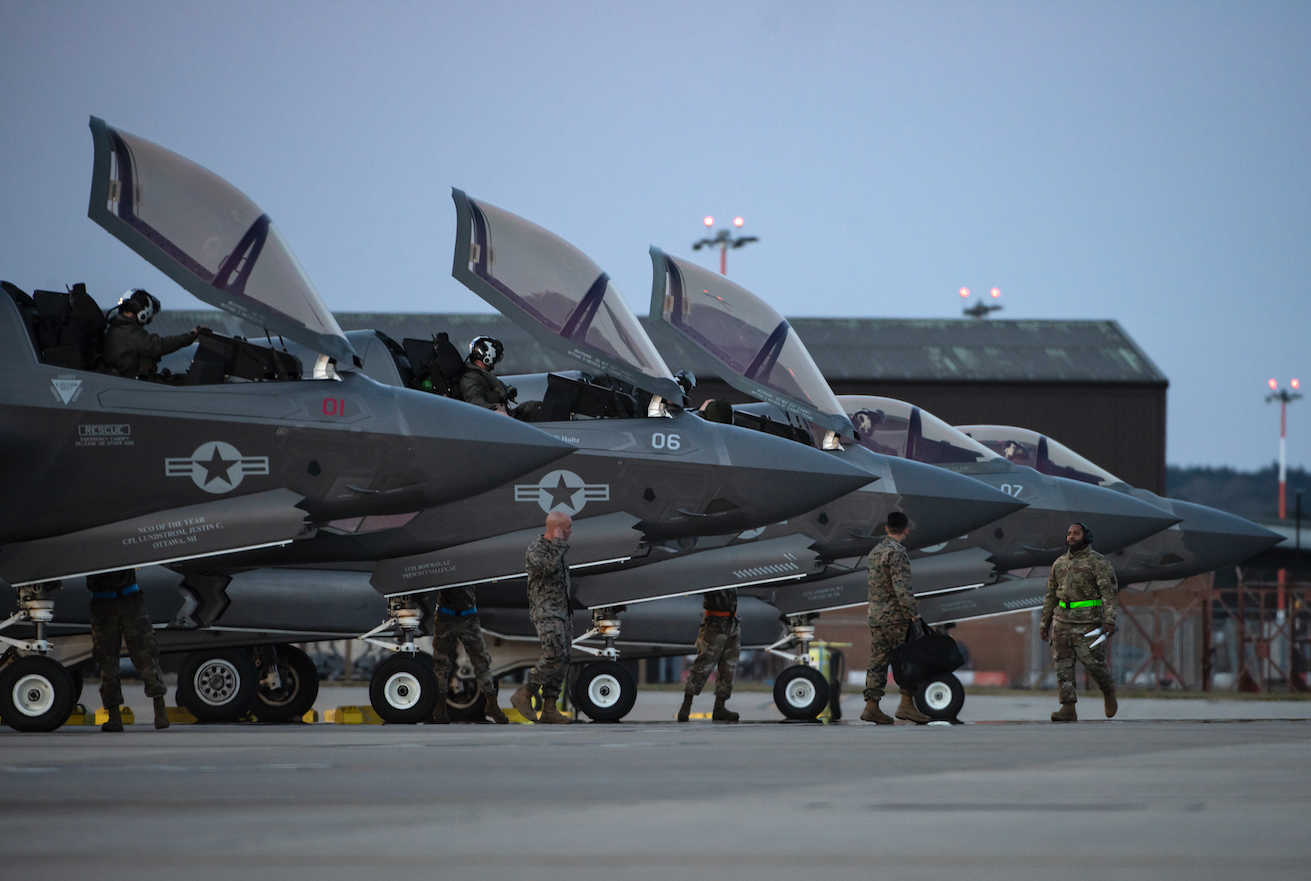
When the “Wake Island Avengers” of U.S. Marine Fighter Attack Squadron (VMFA) 211 land on the United Kingdom’s aircraft carrier, it will mark the largest-ever deployment of F-35 Lightning II Joint Strike Fighters in the history of the program.
After participating in workups last year aboard U.K. Royal Navy HMS Queen Elizabeth (R08), the Marine Corps F-35B squadron and the Royal Air Force’s 617 Squadron “The Dambusters” – 10 fighters with the Marines and eight with the Brits – will begin a seven-month deployment in May that will take them across the Indo-Pacific region with what the Marine Corps is calling “the largest fifth-generation carrier air wing in the world.”
“We have never seen a ship with 18 F-35s out there that is going to transverse half the world like we’re going to do,” Lt. Col. Andrew D’Ambrogi, the commanding officer of VMFA-211, told USNI News in a recent interview. “It’s a pretty bold statement. It’s about power projection.”
While the two squadrons used last year’s pre-deployment drills to show the two countries can operate and maintain the F-35B together from the British carrier, the Marines are hoping the deployment will also showcase what a large formation of F-35s is capable of.
“To have the opportunity to go to a ship – any ship, nonetheless a British ship that’s designed for F-35 – is going to allow us the space and the mission sets to allow us to kind of really test what an entire F-35 squadron can do,” D’Ambrogi said. “So I’m very excited to gather that data and determine if we’ve got it right or give the feedback on how to make it better.”
In a news release this week detailing the deployment, the U.K. defense ministry emphasized the opportunities the multi-national carrier strike group will have to drill with other nations and the deployment’s focus on the Indo-Pacific region.
“The forthcoming deployment will bolster already deep defence partnerships in the region, where the UK is committed to a more enduring regional defence and security presence,” the release reads. “Ships from the Carrier Strike Group will participate in Exercise Bersama Lima to mark the 50th anniversary of the Five Powers Defence Agreement between Malaysia, Singapore, Australia, New Zealand and the United Kingdom.”
The deployment also provides a unique chance for the U.S. Marines and sailors to work with their British counterparts aboard an allied country’s ship on Queen Elizabeth’s maiden deployment.
“I’m most excited about training with the Brits and developing a relationship there and an understanding of how they fight. A lot of the tactics we use are standardized across the F-35 fleet, which is great, and that’s going to set us up for a good baseline for success,” Capt. Craig Turner, an F-35B pilot with VMFA-211, told USNI News. “You can spend an entire career and not interact with some coalition partners. So I’m really looking forward to interacting hand-in-hand.”
Force Design
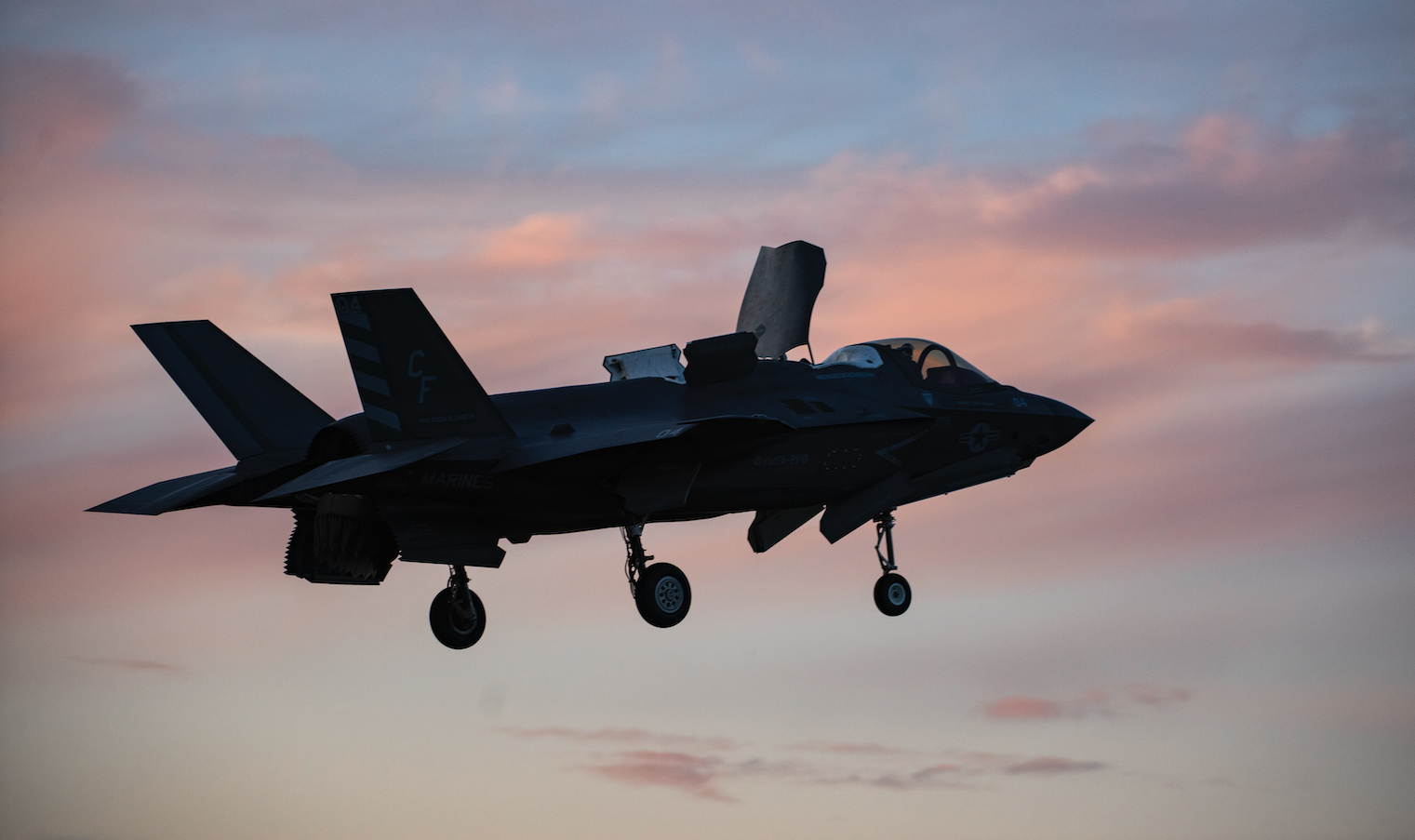
While the Marines have deployed F-35Bs as detachments aboard Navy amphibious ships, the deployment aboard the British carrier will be the first chance for the service to deploy a full 10-aircraft squadron with all of its personnel since Marine Corps Commandant Gen. David Berger cut the number of jets in its F-35 squadrons from 16 aircraft to 10.
The change came out of Berger’s force design initiative to prepare the Marine Corps for a potential conflict in 2030, for which Marine Corps officials have argued the service must shed its heavier equipment so it can operate as a lighter force on islands or shorelines in a region like the Pacific.
Last year’s force design report cut the number of aircraft per squadron to 10 and said the Marine Corps needed to do more experimentation to better ascertain how it would use the F-35Bs and Cs. This month’s update from the Marine Corps after a year of experimentation raised concerns about having sufficient maintenance personnel to sustain the F-35 aircraft.
The deployment on Queen Elizabeth will help the Marines answer some of these questions.
“In the larger eyes of the Marine Corps, I think this is a huge win for force design. So [the] commandant was preaching, ‘hey, the only way I’m going to know about force design is for people to get out there and start executing it.’ And right now, this will be the first time a Marine Corps F-35 squadron actually deploys to their [task order] of 10 airplane[s], all their maintainers and qualifications,” D’Ambrogi said of the new number of aircraft in the squadron.
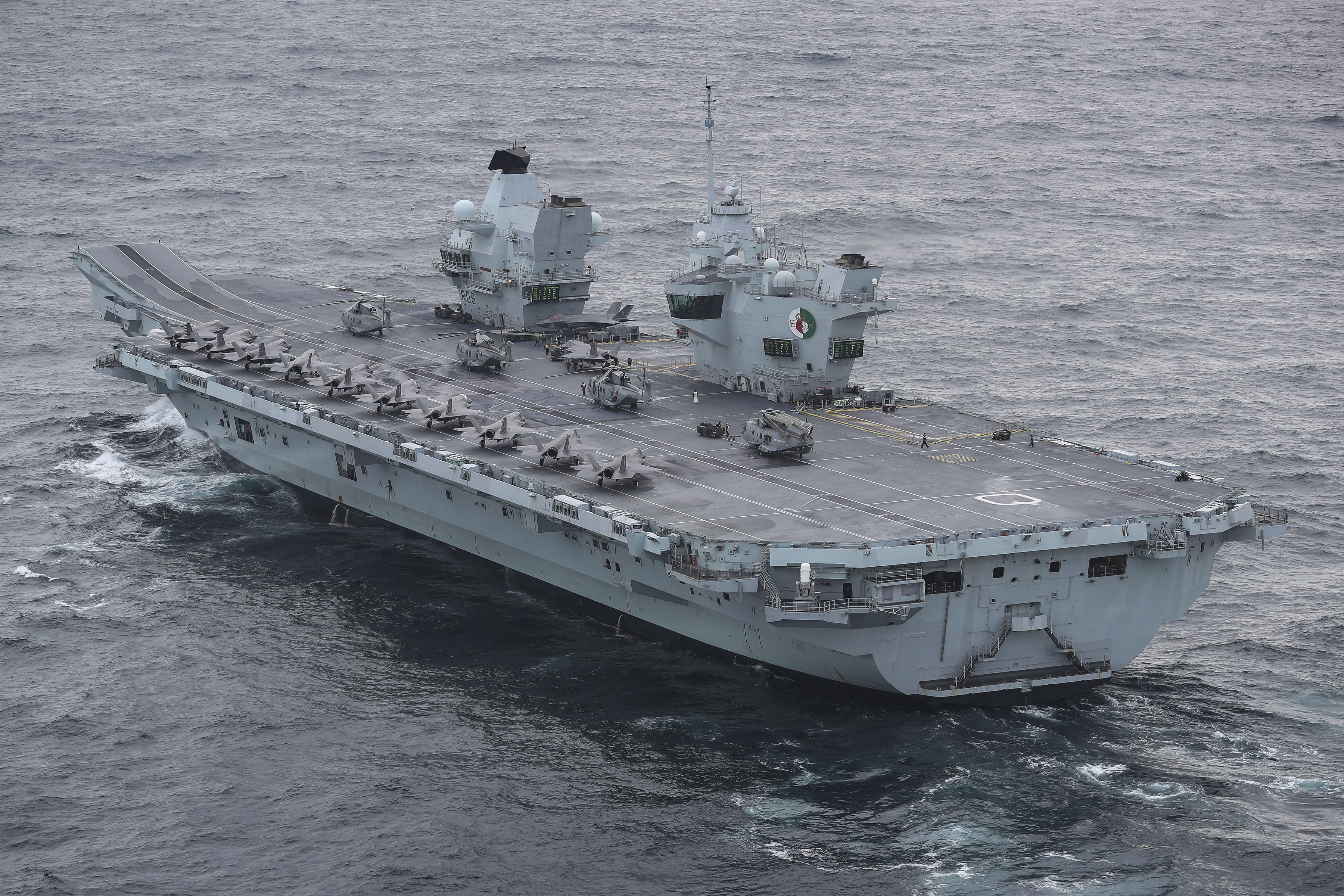
With 10 jets and 180 U.S. Marines forming the squadron, the deployment will help the Marine Corps determine not only whether it has the right number of aircraft, but also if it has the correct number and kind of personnel and overall maintenance procedures.
“We want to make sure that we’ve got the right type of Marines trained to the right type of jobs. And then make sure that we have the right qualifications to sustain all 10 aircraft and meet the mission cycle flows for what we’re executing. A shipboard environment’s great to do it because you’re isolated. What you’ve got is kind of what you’ve got, and anything you need from the exterior is going to take some time,” D’Ambrogi told USNI News.
“So if your people aren’t trained or you don’t have that appropriate skillset, or even the tooling – we’ll find it if we have the right tooling and the right supply sparing – that can all be validated for support of an entire squadron,” he continued. “I think all that is great data. And if we don’t, we come back to the drawing board and say, ‘we need more people in this area. We need less people in that area.’”
While the force design initiative is an ongoing effort within the Marine Corps, Berger has repeatedly emphasized that experimentation will help the service refine various aspects of its future force, including how the Marines will use the F-35 in operations. With 10 American F-35s operating from Queen Elizabeth for seven months, the deployment provides the Marines that type of opportunity.
Interoperability and Working with the Brits
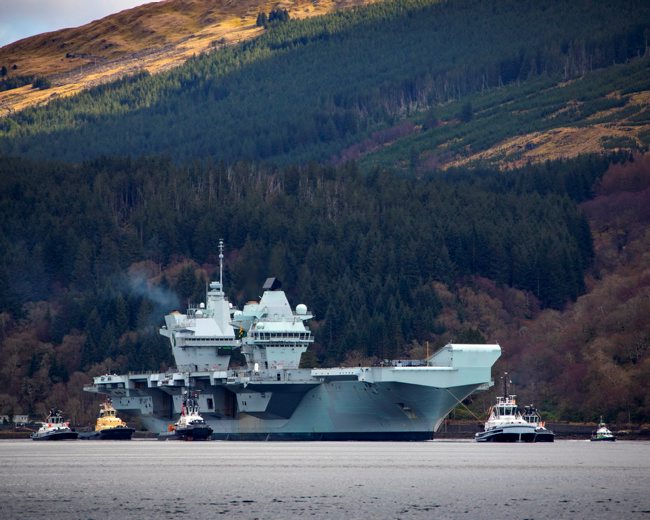
Marine Corps officials say the joint features of the F-35 program are particularly suited for the type of interoperable deployment the U.S., U.K. and other partner nations are embarking on for the Queen Elizabeth-led CSG.
Turner told USNI News that, because of how the program was designed, flying the aircraft with the U.K. pilots during last year’s training happened quickly.
“I met a lot of these British pilots – you know, a large portion of them for the first time last September – and within the week we could go out and fly together because we had everything from the flight manual to the tactics publications that were kind of all speaking the same language,” he said.
Sgt. Samuel Johnson, a powerline mechanic with the squadron, told USNI News that the Marines have been performing “non-stop maintenance and preparation” to gear up for the deployment since the training wrapped last fall.
“Working with us was the engineers for the aircraft. We’ve come up with extra parts that we need to have on spare if we do need to replace them, just anticipating that they could go bad,” Johnson said. “But working with the British – their supply system on the boat is actually really good.”
Marine Corps officials previously told USNI News that the two squadrons during pre-deployment training flew in formations with both U.S. and U.K. planes and swapped parts for the aircraft.
For example, the U.S. Marines during last year’s training used a part needed for an F-35’s Integrated Power Pack (IPP), which delivers electrical power to the aircraft, from the U.K.’s supply line onboard, according to Johnson.
While much of the core maintenance for the aircraft is the same, Johnson noted that the U.S. Marines on Queen Elizabeth will do more on the flight deck than they would on a U.S. amphib like Wasp-class amphibious assault ship USS Essex (LHD-2), the ship he last deployed on with the squadron.
The Marines will need to fuel the aircraft while aboard the British carrier, a task that the U.S. Navy typically handles for F-35s on American ships.
“Our Navy handles basically every aspect of the flight operations after the engine’s started up on the aircraft. You know, the plane captain or the crew chief, as the Air Force might call it, is going to be up there,” Johnson said. “They’re going to get the pilot in the aircraft. They’re going to get started up. They’re going to ensure safety of the flight deck, make sure the aircraft starts up good, and any troubleshooting.”
“However, on this aircraft carrier with the U.K., the Queen Elizabeth, the Marines are going to be responsible for that,” he continued. “So we don’t necessarily just turn it over to them, and it’s hands off. So we’re going to have to take all the chains off the aircraft. We’re going to have to run the fuel hoses, run the fuel pumps. So it’s a lot more, as far as the daily flight schedule.”
To learn how to remove the chains, for example, the U.S. Marines took some classes last fall with the Brits during the work-up.
Deploying with VMFA-211 is also a team of 18 ordnance sailors from aircraft carrier USS John Stennis (CVN-74), which is currently awaiting the start of its mid-life refueling and complex overhaul in Virginia.
Lt. Mike Brown, an aviation ordnance officer with the Navy, told USNI News that his team is deploying with the squadron because U.S. Marines do not build their ordnance when operating on an American ship. This is a task completed by the ship’s company.
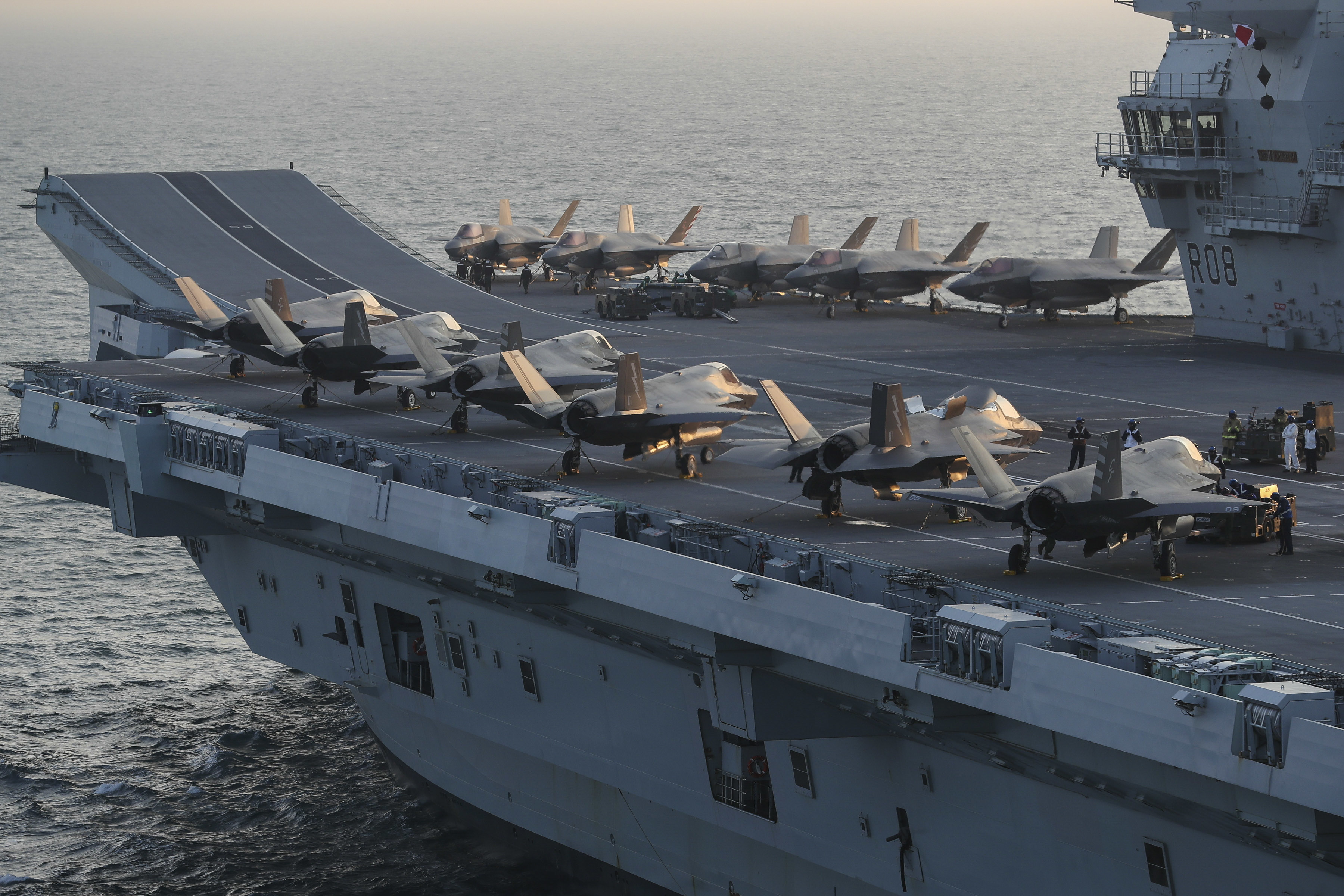
While policy does not allow the U.K. and U.S. to build each other’s ordnance, Brown said the objective during the deployment is for his team to learn from the U.K.’s air weapons party how it builds its ordnance.
Because it’s been years since the U.K. operated an aircraft carrier, Brown said his ordnance team will help the British team with its methods and noted the Royal Air Force had been building the U.K. team’s weapons.
Brown, who also trained last year aboard Queen Elizabeth, said his team will need to assemble ordnance differently on the U.K. carrier than it would on an American ship because of how the British organize the magazines in the ship.
“Typically on a carrier or an amphib, we build our ordnance in the magazines. We have specific ordnance magazines that are set up just to build weapons, like GBUs,” Brown said.
“Their magazines are just for storage – it’s like a warehouse. And then they bring it up to a weapons assembly area, so all the components we have to put together up there vice having them ready access in the same magazine,” he added. “We just kind of grab it, put it together, and then send it up as a whole weapon.”
The two teams will work in separate bays to make the weapons but will do so simultaneously, Brown said.
Deployment Details
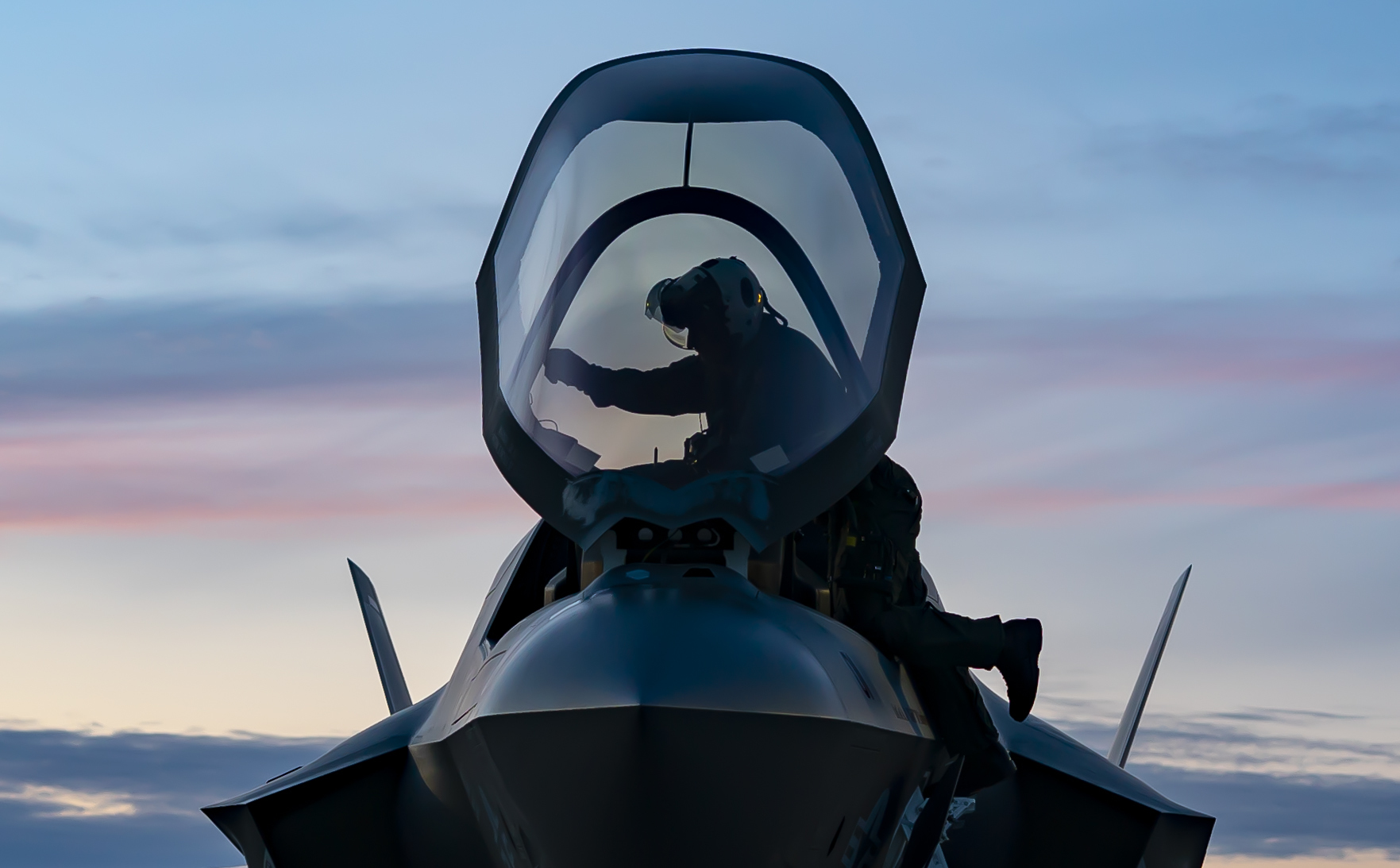
Fighters from VMFA-211, which is headquartered in Yuma, Ariz., landed in the U.K. this week before they fly out to the aircraft carrier in the coming days.
In addition to Marines from VMFA-211 and sailors from Stennis, the carrier strike group for Queen Elizabeth‘s maiden deployment will also include Dutch frigate HNLMS Evertsen (F805) and U.S. Navy destroyer USS The Sullivans (DDG-68), according to the U.K. news release.
“Joining her will be a surface fleet of Type 45 destroyers, HMS Defender and HMS Diamond, Type 23 anti-submarine frigates HMS Kent and HMS Richmond, and the Royal Fleet Auxiliary’s RFA Fort Victoria and RFA Tidespring,” the news release reads. “Deep below the surface, a Royal Navy Astute-class submarine will be deployed in support, armed with Tomahawk cruise missiles.”
The deployment will take the multi-national CSG through both the Mediterranean and the Indo-Pacific and feature chances for the ships to drill with different countries around the world.
“On a 28-week deployment spanning 26,000 nautical miles, the carrier strike group will conduct engagements with Singapore, the Republic of Korea, Japan and India as part of the U.K.’s tilt towards the Indo-Pacific region,” the U.K. said in the release. “Units from the carrier strike group are expected to visit more than 40 countries and undertake over 70 engagements.”
D’Ambrogi said the British-led CSG will likely drill with a U.S. Navy CSG in U.S. Indo-Pacific Command during the deployment.
“We’re looking to do some integration with other U.S. follow-on forces once we get into INDOPACOM,” he said. “So looking at a U.S. carrier strike group to probably a U.S. [Marine Expeditionary Unit]-[Amphibious Ready Group] to do a large exercise as well, integrated with them.”
While the deployment provides the U.S., U.K. and member countries in NATO the chance to hone interoperability, it gives U.S. Marines and sailors a rare chance to deploy on another country’s aircraft carrier.
“Looking back in time when I went on my first deployment, everyone said ‘you only get your first deployment once.’ And that’s just kind of the new and novel aspects of it are obviously only the first time that you do it.” Turner, the F-35B pilot, told USNI News.
“And one thing that I think is really neat about this deployment is – for me personally, I kind of get a first deployment over again,” he added.





